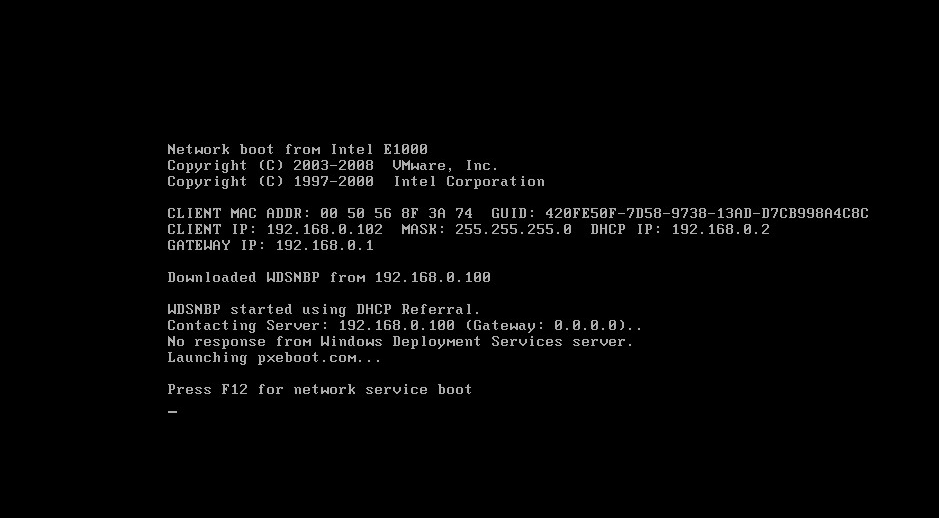Search the Community
Showing results for tags 'PXE Boot'.
-
Dear Experts, I Would like to get some inputs from you Please. My Data Center is located in 2 Regions. This data center is supplying the services (Windows Server, Network., etc) At Present we are planning to perform SCCM CB Implementation with High Availability for SCCM Client Roles....
- 8 replies
-
- sccm
- current branch
-
(and 8 more)
Tagged with:
-
After upgrading to 1511 and ADK win10 and running the patch kb314370, F12 a client and get "No boot file name available". Cannot get F8 to open a cmd prompt for support logs either, yes it is enabled. Both the new (x86 and x64 from ADK) boot images are distributed and have WinPE 10 drivers....
-
Hi, We currently have a server which handles DHCP and WDS (lets say server A) I've set up a new SCCM server (server B ) and would like PXE boot request to be handled by the new SCCM server, whilst keeping DHCP on the old server (A). At the moment, DHCP points PXE requests to the same server (A)....
-
We just finished upgrading our SCCM Servers both our CAS and PS1 to SCCM 2012 R2 SP1. After the upgrade it seems that the new boot.wim file that is created is having issues. After the machine pxe boots and pulls down the wim file, it goes to windows is starting up then preparing network connect...
- 3 replies
-
- SCCM 2012 R2 SP1
- PXE boot
-
(and 3 more)
Tagged with:
-
Hi ; I want Lenovo Thinkpad 10 with PXE but I have error "PXE-E10: Server response timeout" What does mean "PXE-E10: Server response timeout" ? I used USB 3.0 Ethernet dongle. How to resolve this problem. Thanks.
- 3 replies
-
- PXE-E10: Server response time
- Lenovo Thinkpad 10
-
(and 1 more)
Tagged with:
-
Hi everyone, I am currently trying to use WDS on Windows Server 2012 r2. I also have the MDT 2012 and Windows ADK 8.1 installed. I am however, just trying to get WDS barebone working at the moment. I have had WDS working as a standalone but when I moved it to be integrated with Active Directory...
- 1 reply
-
- WDS
- Windows Deployment
-
(and 2 more)
Tagged with:
-
In Configuration Manager, you right click on a resource and select Clear Last PXE Advertisement a window would appear and if a PXE Flag occurred you would see an Advertisement. I am working on a Front End tool for a client and one of their request is to be able to see if a workstation has a PXE Adv...
-
I am attempting to deploy a task sequence containing an OS image we recently captured via SCCM Capture Image task. The issue is, we are unable to PXE boot into the sequence. WDS keeps taking over the process. This is a manually entered bare bones VM with no OS currently installed on it. Any help get...
-
Applying operting system failed with error code 0x80070002
alex_help posted a question in How do I ?
hello, im using SCCM 2012 and trying to PXE boot and getting this error below this image works fine on Virtual Machines All we can see in the SMTS.log is: Error downloading file from http://MSGAP15.markerstudy.local:80/SMS_DP_SMSPKG$/MSG00091/sccm?/MSG_W7_ENT_x64_v1.0.WIM to C... -
Hello All, I'm trying to image a Dell Precision M6800. It PXE boots and pulls the boot wim fine but once it gets into the task sequence area it will just reboot. I can't seem to pull an IP address to it at all but it PXE boots fine. This is the only laptop that does this. Even the previous M6700...
-
hi, in my infra,i have both SCCM 2007 & 2012 Serverwith PXE Enabled settings. when i m booting up my targeted machine it is booting & contacting to only SCCM 2007 server,not to SCCM 2012 server. I want that my machine contact with SCCM 2012 Server. or there can be selection list to choose SCC...
-
I can import computer information into my collection once and it will PXE boot once. After the first time no matter if the computer successfully installed the image or failed I cannot boot into PXE anymore on that same computer. I can add a brand new computer out of the box and it will PXE boot one...
-
Hi there. Looking for some advise regarding Windows 7 deployment & PXE Booting. Background - we are using sccm 2007 & mdt 2010, and are currently in the middle of a project to migrate our OS to Windows 7. We have a server (sccmbr01) which has been added as an sccm site-system, which contains the...
-
Hi All, I am trying to deploy my captured Win7 image to a VM as a test before I try it on a real PC. My setup is as follows: Main SCCM server: Win 2008 R2, SCCM 2007 SP2 R3; Roles: Comp Svr, MP, DMP, DP, RP, SLP, Site server and system SCCM PXE Server: Win 2008 R2; Roles: Comp Svr, PXE SP,...
-
HI there, I have just got working PXE boot working again after having to remove the PXE service point and WDS. I also upgraded to SCCM R3 PXE is working, I have built 3 machines by importing the computer information and 1 machine as an "unknown computer" The issue I’m having is that it t...





